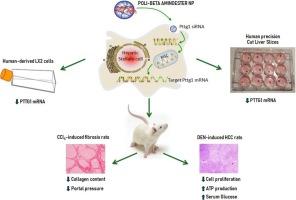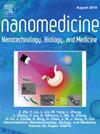Polymeric nanoparticles for liver-targeted pituitary tumor-transforming gene 1 silencing in rats with chronic liver disease
IF 4.6
2区 医学
Q2 MEDICINE, RESEARCH & EXPERIMENTAL
Nanomedicine : nanotechnology, biology, and medicine
Pub Date : 2025-09-25
DOI:10.1016/j.nano.2025.102860
引用次数: 0
Abstract
Pituitary tumor transforming gene 1 (Pttg1) is upregulated in cirrhosis and hepatocarcinoma (HCC). We assessed the therapeutic effect of liver-targeted Pttg1 siRNA Retinol (Ret) pBAE nanoparticles (NPs) to treat these disturbances. Fibrosis was induced in Wistar rats by carbon tetrachloride inhalation and HCC by diethylnitrosamine injection. Ret pBAE NPs accumulated in hepatic tissue, close to zones positive for αSMA staining. Pttg1 interference increased mean arterial pressure, reduced portal hypertension and decreased collagen accumulation and inflammatory infiltrate in fibrotic rats. In HCC rats, Pttg1 silencing reduced liver to body weight ratio and hepatic proliferation and increased hepatic ATP production and serum glucose. This therapy effectively mitigated liver fibrosis and HCC progression in experimental models. The feasibility of this treatment was also demonstrated in human derived hepatic stellate cells and in ex vivo human cirrhotic livers underscoring the therapeutic potential of Pttg1 siRNA Ret pBAE NPs in addressing liver fibrosis and HCC.

聚合纳米颗粒用于慢性肝病大鼠肝靶向垂体肿瘤转化基因1的沉默
垂体肿瘤转化基因1 (Pttg1)在肝硬化和肝癌中表达上调。我们评估了肝脏靶向Pttg1 siRNA视黄醇(Ret) pBAE纳米颗粒(NPs)治疗这些紊乱的疗效。吸入四氯化碳和注射二乙基亚硝胺诱导Wistar大鼠肝纤维化。肝组织中paenps聚集,靠近α - sma染色阳性区。Pttg1干扰使纤维化大鼠平均动脉压升高,门静脉高压降低,胶原积累和炎症浸润减少。在HCC大鼠中,Pttg1沉默降低肝体重比和肝脏增殖,增加肝脏ATP生成和血清葡萄糖。在实验模型中,该疗法有效地减轻了肝纤维化和HCC的进展。这种治疗的可行性也在人源性肝星状细胞和离体人肝硬化肝脏中得到证实,强调了Pttg1 siRNA Ret pbanps在治疗肝纤维化和HCC方面的治疗潜力。
本文章由计算机程序翻译,如有差异,请以英文原文为准。
求助全文
约1分钟内获得全文
求助全文
来源期刊
CiteScore
11.10
自引率
0.00%
发文量
133
审稿时长
42 days
期刊介绍:
The mission of Nanomedicine: Nanotechnology, Biology, and Medicine (Nanomedicine: NBM) is to promote the emerging interdisciplinary field of nanomedicine.
Nanomedicine: NBM is an international, peer-reviewed journal presenting novel, significant, and interdisciplinary theoretical and experimental results related to nanoscience and nanotechnology in the life and health sciences. Content includes basic, translational, and clinical research addressing diagnosis, treatment, monitoring, prediction, and prevention of diseases.

 求助内容:
求助内容: 应助结果提醒方式:
应助结果提醒方式:


